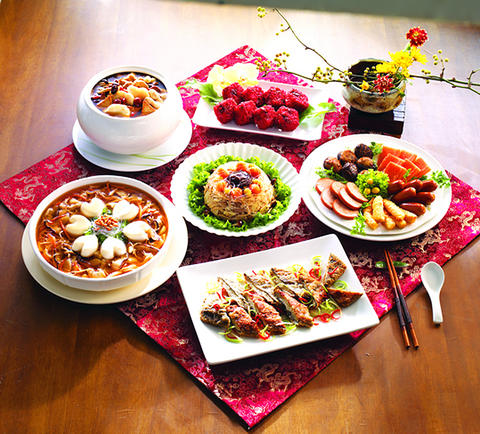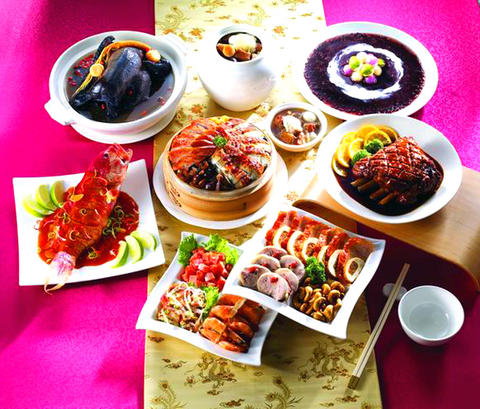The Lunar New Year has many traditions associated with it, and while many of these are gradually being thrown out the window by a generation too preoccupied to bother, the New Year's Eve family dinner remains entrenched in Taiwanese society. All kinds of dishes, many of them bad for the waistline and blood pressure, are essential to see in the New Year properly, for, as we are told, each dish has important symbolic significance.
The first dish on a New Year's Eve menu is often a cold mixed platter, usually with a choice of five types of food. Regularly to be seen are haizhepi (海哲皮), shrimp, stewed beef, tripe and cold-cuts of chicken. It's the number of choices rather than what's on the plate that is significant in this case. This dish is a reference to the phrase "may you be granted the five blessing" (五福臨門, wufulinmen), a commonly used auspicious saying. There is some debate as to exactly what the five blessings are, but the most commonly accepted version includes longevity, prosperity, official status, joy and numerous offspring.
Fish is an absolute must at the New Year's Eve table, largely because of a homophone. The word fish (魚, yu) sounds the same as "surplus" (餘, yu), so the eating of fish represents the hope that the following year will be one of abundance. The type of fish and the manner in which it is cooked are left to the discretion of the chef.

PHOTO COURTESY OF PRESIDENT CONVENIENCE STORES
A whole chicken is also often thought a necessary part of the meal. This is partly due to a kind of rhyming aphorism in Hoklo (commonly known as Taiwanese), "Eat a chicken, establish a home" (吃雞起家, chiah ke, khi ke), which doesn't make a lot of sense in English when translated directly, but given that the holiday is a time for families to get together, the concept of family unity can be read into almost anything. (Meatballs are another popular way of expressing this in the language of food, simply because they are round.) The use of specially bred black-boned chickens gives the dish additional cachet, as this variety is thought to have medicinal properties that will fortify the body against winter weather.
Fortunately, given the excess of fish and meat that is served up at most Lunar New Year's Eve dinners, a number of vegetables also have auspicious references.
Mustard greens are commonly consumed during the holiday because in Chinese they are called "long years vegetable" (長年菜, changniancai), an auspicious reference to living to a ripe old age.

PHOTO COURTESY OF PRESIDENT CONVENIENCE STORES
Fat choy (髮菜), also known as hair moss (Latin name: Nostoc flagelliforme), a dried fungus harvested in the high deserts of Central Asia, is another common food. It's expensive, adding a certain prestige, but the main reason for its inclusion is that in Cantonese, the name of the vegetable is a homophone for "get rich," which is presumably what everybody is hoping to do as soon as the festivities are over.
It's not only expensive foods that make the cut; the radish is also traditionally part of the meal. In Hoklo, radish (菜頭, chhai-thau) is a homophone for "good fortune" (好彩頭 ho-chhai-thau). To ensure that the radish isn't embarrassed because of its humble origins, it's often served as radish cake, which dresses the vegetable up with shrimp, dried mushrooms and other more costly ingredients.
These are just some of the associations between food and folklore that are brought to the fore over the Lunar New Year, but the ultimate demand is that the food be exotic and varied. For this reason, one of the most popular choices is the dish "Buddha jumps over the wall" (佛跳牆, fotiaoqiang), a Minnan (閩南) stew or soup made of quail eggs, bamboo shoots, scallops, sea cucumbers, abalone, shark fin, chicken, ham, pork tendon, ginseng, mushrooms and taro, all cooked in a wine-based soup. It got its name from a story in which a Buddhist monk forgot his vows (which include not eating meat) and jumped over a garden wall to get a taste of this dish. The concoction comes in many forms and ranges in price from a few hundred NT dollars to many thousands. This show-off stew has no particular traditional relationship with the Lunar New Year other than providing almost limitless opportunities for the addition of pricey and exotic ingredients.
Preparing all of this food entails a good deal of cooking, and few families in urban centers have time to make such elaborate preparations. According to a study commissioned by the President Chain Stores (統一超商), which operates the 7-Eleven convenience store franchise, 75 percent of families in Taiwan now get takeout for New Year's Eve. The company has responded, as has virtually every other convenience store and hypermarket chain, with a huge selection of pre-ordered, pre-cooked and pre-packaged banquets. Restaurants, too, are currently accepting bookings and takeout orders for New Year's Eve foods and if you are looking to celebrate in traditional style without the hassle of cooking yourself, you should probably start getting your orders in now.

Exceptions to the rule are sometimes revealing. For a brief few years, there was an emerging ideological split between the Democratic Progressive Party (DPP) and Chinese Nationalist Party (KMT) that appeared to be pushing the DPP in a direction that would be considered more liberal, and the KMT more conservative. In the previous column, “The KMT-DPP’s bureaucrat-led developmental state” (Dec. 11, page 12), we examined how Taiwan’s democratic system developed, and how both the two main parties largely accepted a similar consensus on how Taiwan should be run domestically and did not split along the left-right lines more familiar in

As I finally slid into the warm embrace of the hot, clifftop pool, it was a serene moment of reflection. The sound of the river reflected off the cave walls, the white of our camping lights reflected off the dark, shimmering surface of the water, and I reflected on how fortunate I was to be here. After all, the beautiful walk through narrow canyons that had brought us here had been inaccessible for five years — and will be again soon. The day had started at the Huisun Forest Area (惠蓀林場), at the end of Nantou County Route 80, north and east

This month the government ordered a one-year block of Xiaohongshu (小紅書) or Rednote, a Chinese social media platform with more than 3 million users in Taiwan. The government pointed to widespread fraud activity on the platform, along with cybersecurity failures. Officials said that they had reached out to the company and asked it to change. However, they received no response. The pro-China parties, the Chinese Nationalist Party (KMT) and Taiwan People’s Party (TPP), immediately swung into action, denouncing the ban as an attack on free speech. This “free speech” claim was then echoed by the People’s Republic of China (PRC),

Specialty sandwiches loaded with the contents of an entire charcuterie board, overflowing with sauces, creams and all manner of creative add-ons, is perhaps one of the biggest global food trends of this year. From London to New York, lines form down the block for mortadella, burrata, pistachio and more stuffed between slices of fresh sourdough, rye or focaccia. To try the trend in Taipei, Munchies Mafia is for sure the spot — could this be the best sandwich in town? Carlos from Spain and Sergio from Mexico opened this spot just seven months ago. The two met working in the